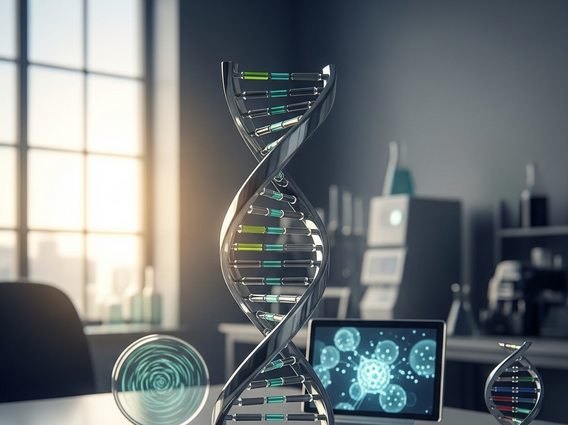Gene-Environment Interactions and Cancer Risk
Cancer is a complex disease, and its development is rarely attributable to a single cause. Instead, it often arises from a dynamic interplay between an individual’s genetic makeup and their surrounding environment. Understanding these gene-environment interactions cancer risk is crucial for both prevention and treatment strategies.

Key Takeaways
- Cancer development is a result of complex gene-environment interactions, where genetic predispositions meet environmental triggers.
- Environmental factors can directly damage DNA or alter gene expression, influencing an individual’s cancer risk genes environmental influences.
- Both inherited genetic variations and lifestyle choices play a significant role in determining an individual’s vulnerability to cancer.
- Research into the gene-environment cancer link is advancing, leading to more personalized prevention and treatment approaches.
- Modifying environmental exposures and adopting healthy lifestyles are key strategies for reducing the overall gene environment cancer risk.
Understanding Gene Environment Cancer
The concept of gene environment cancer highlights that an individual’s susceptibility to cancer is not solely determined by their inherited genes or by their exposure to environmental factors alone. Rather, it’s the intricate dance between the two that often dictates disease onset and progression. This interplay helps explain why some individuals exposed to carcinogens develop cancer, while others do not, or why certain genetic mutations only manifest as disease under specific environmental conditions.
Defining the gene-environment cancer link
The gene-environment cancer link refers to the phenomenon where genetic predispositions interact with environmental exposures to influence an individual’s risk of developing cancer. This interaction can be synergistic, meaning the combined effect is greater than the sum of their individual effects. For instance, a person with a particular genetic variant might be more susceptible to the carcinogenic effects of tobacco smoke than someone without that variant, illustrating how genes and environment cause cancer together.
Why understanding gene environment cancer matters
A deep understanding of gene environment cancer is paramount for several reasons. It allows for more accurate risk assessment, enabling targeted screening and early detection for individuals at higher risk. Furthermore, it informs the development of personalized prevention strategies, moving beyond one-size-fits-all advice. By unraveling the complex role of genetics and environment in cancer, researchers can identify novel therapeutic targets and design more effective interventions.
The complex role of genetics and environment in cancer
The role of genetics and environment in cancer is multifaceted. Genetic factors can include inherited mutations that increase cancer risk (e.g., BRCA1/2 for breast and ovarian cancer) or variations in genes that affect how the body metabolizes carcinogens or repairs DNA damage. Environmental factors encompass a wide range of exposures, from lifestyle choices like diet and smoking to occupational hazards, pollution, and infectious agents. It is the specific combination and timing of these factors that ultimately contribute to an individual’s overall cancer risk.
- Genetic Predisposition: Inherited genes can make individuals more vulnerable to environmental carcinogens.
- Environmental Triggers: External factors can induce genetic changes or promote cancer growth in susceptible individuals.
- Synergistic Effects: The interaction often amplifies the risk beyond what either factor would cause alone.
- Personalized Risk: Understanding this link allows for more tailored risk assessments and prevention plans.
Mechanisms of Gene Environment Cancer
Delving into the mechanisms of gene environment cancer reveals the intricate molecular and cellular pathways through which external factors and internal genetic predispositions converge to initiate and promote cancer development. It’s not just about exposure, but how the body processes and responds to that exposure based on its genetic blueprint.
How genes and environment cause cancer
The process of how genes and environment cause cancer involves several key mechanisms. Environmental carcinogens can directly damage DNA, leading to mutations. If these mutations occur in critical genes (like tumor suppressor genes or oncogenes) and are not repaired, they can drive uncontrolled cell growth. Genetic factors, such as variations in DNA repair genes or genes involved in detoxification pathways, can influence an individual’s ability to counteract these environmental assaults. For example, individuals with less efficient detoxification enzymes might accumulate more toxins, increasing their risk.
Environmental impact on cancer genetics
The environmental impact on cancer genetics extends beyond direct DNA damage. Environmental factors can also induce epigenetic changes, which are modifications to gene expression that do not alter the underlying DNA sequence. These changes, such as DNA methylation or histone modification, can switch genes on or off, affecting cell growth, differentiation, and DNA repair. For instance, certain dietary components or pollutants can alter epigenetic marks, potentially activating oncogenes or silencing tumor suppressor genes, thereby contributing to gene environment cancer development.
Pathways of gene-environment interactions cancer risk
The pathways of gene-environment interactions cancer risk are diverse and complex. They often involve a cascade of events:
- DNA Damage and Repair: Environmental carcinogens cause DNA lesions, and genetic variations in DNA repair pathways determine the efficiency of damage correction.
- Metabolism of Carcinogens: Genes encoding enzymes involved in metabolizing environmental toxins can influence the activation or detoxification of these substances.
- Immune Response: Genetic variations in immune system genes can affect the body’s ability to detect and eliminate nascent cancer cells, influenced by environmental factors like chronic inflammation.
- Hormonal Regulation: Environmental endocrine disruptors can interact with genetically determined hormonal pathways, increasing the risk for hormone-sensitive cancers.
Understanding these pathways is key to developing targeted interventions.
Genetic Factors in Gene Environment Cancer
Genetic factors lay the groundwork for an individual’s susceptibility to cancer, but they rarely act in isolation. Instead, they interact dynamically with environmental influences, shaping the overall gene environment cancer risk. This section explores how inherited genetic variations contribute to cancer vulnerability.
Cancer risk genes and environmental influences
Many cancer risk genes environmental influences are well-documented. For example, mutations in genes like BRCA1 and BRCA2 significantly increase the risk of breast and ovarian cancers. However, even with these high-risk mutations, environmental factors and lifestyle choices can modify the actual risk. A person with a BRCA mutation who also has a history of heavy alcohol consumption or exposure to certain chemicals might face an even higher risk than someone with the same mutation but fewer environmental exposures. Similarly, genes involved in detoxification, like GSTM1, can influence how effectively the body processes environmental carcinogens, highlighting the crucial interplay.
Inherited predispositions to gene environment cancer
Inherited predispositions to gene environment cancer stem from germline mutations passed down through families. These mutations can affect various cellular processes, including DNA repair, cell cycle control, and tumor suppression. Examples include mutations in TP53 (Li-Fraumeni syndrome), APC (familial adenomatous polyposis), and Lynch syndrome genes (MLH1, MSH2, MSH6, PMS2). While these genetic factors significantly elevate risk, the penetrance of these mutations (the likelihood of developing cancer) can still be modulated by environmental factors, emphasizing that even strong genetic links are part of a broader gene-environment interaction.
Genetic and environmental factors cancer vulnerability
The interplay of genetic and environmental factors cancer vulnerability is complex. An individual’s unique genetic profile can determine how they respond to specific environmental exposures. For instance, some genetic variants might make a person more susceptible to the DNA-damaging effects of UV radiation, increasing their risk of skin cancer, especially if they have prolonged sun exposure. Conversely, other genetic variations might confer a degree of protection. This intricate relationship means that assessing cancer risk requires considering both an individual’s inherited genetic background and their lifetime environmental exposures, rather than focusing on one in isolation.
| Genetic Factor Example | Associated Cancer Risk | Environmental Influence |
|---|---|---|
| BRCA1/2 mutations | Breast, Ovarian, Prostate | Alcohol consumption, hormone therapy, radiation exposure |
| GSTM1 deletion | Lung, Bladder | Tobacco smoke, occupational chemicals |
| TP53 mutations | Multiple cancers (Li-Fraumeni) | Radiation, certain chemical exposures |
| NAT2 slow acetylator | Bladder, Colorectal | Aromatic amines (e.g., in dyes, tobacco smoke) |
Environmental Influences on Gene Environment Cancer
While genetics provide the blueprint, environmental influences often act as the architects, shaping how that blueprint is expressed and whether cancer ultimately develops. These external factors are critical components of the gene environment cancer equation, offering significant opportunities for prevention.
Lifestyle and environmental factors cancer
A wide array of lifestyle and environmental factors cancer risk. These include dietary habits, physical activity levels, smoking, alcohol consumption, and exposure to various pollutants. For example, a diet high in processed foods and low in fruits and vegetables can contribute to chronic inflammation and oxidative stress, which can damage DNA and promote cancer growth. Similarly, a sedentary lifestyle is linked to increased risk for several cancer types. These lifestyle choices don’t just act independently; they interact with an individual’s genetic predispositions, modifying their overall susceptibility.
Exposures shaping gene environment cancer risk
Specific exposures play a direct role in shaping gene environment cancer risk. Tobacco smoke, for instance, contains numerous carcinogens that directly damage DNA and interfere with DNA repair mechanisms. Exposure to asbestos can lead to mesothelioma, especially in individuals with certain genetic susceptibilities. Ionizing radiation (from medical imaging, occupational exposure, or natural sources) is another well-known carcinogen. Furthermore, chronic infections (e.g., HPV, Hepatitis B/C) can cause persistent inflammation and cellular damage, increasing cancer risk, particularly in genetically predisposed individuals. The cumulative effect of these exposures over a lifetime is a significant determinant of cancer development.
Modifiable risks for gene environment cancer
Crucially, many of the environmental influences on cancer are modifiable, offering powerful avenues for prevention. Reducing environmental impact on cancer genetics involves both individual choices and broader public health initiatives. For individuals, this means adopting a healthy diet, maintaining a healthy weight, engaging in regular physical activity, avoiding tobacco, limiting alcohol intake, and protecting against excessive sun exposure. On a societal level, it involves regulating pollutants, ensuring safe workplaces, and promoting vaccination against cancer-causing infections. By addressing these modifiable risks, we can significantly lower the incidence of gene environment cancer.
- Diet: High intake of processed foods, red meat; low intake of fruits, vegetables, fiber.
- Physical Inactivity: Sedentary lifestyle linked to increased risk for several cancers.
- Tobacco Use: Direct exposure to carcinogens, impacting multiple cancer types.
- Alcohol Consumption: Increases risk for liver, breast, colorectal, and other cancers.
- Pollution: Exposure to air pollutants, industrial chemicals, and pesticides.
- Infections: Viruses (HPV, HBV, HCV) and bacteria (H. pylori) can cause chronic inflammation and DNA damage.
- Radiation: UV radiation from sun, ionizing radiation from medical or occupational sources.
Researching Gene Environment Cancer Links
The field of cancer research is continuously evolving, with significant efforts dedicated to unraveling the intricate gene-environment cancer link. Advances in technology and methodology are providing unprecedented insights into how genetic and environmental factors cancer risk.
Advances in understanding gene-environment cancer link
Recent advances in understanding gene-environment cancer link have been propelled by high-throughput technologies such as genomics, epigenomics, transcriptomics, and metabolomics. These “omics” approaches allow researchers to comprehensively analyze genetic variations, epigenetic modifications, gene expression patterns, and metabolic profiles in large populations. This has enabled the identification of subtle gene-environment interactions that were previously undetectable, offering a more holistic view of cancer etiology. For instance, studies are now able to pinpoint specific genetic variants that modify an individual’s response to particular dietary components or environmental toxins.
Studying genetic and environmental factors cancer
Studying genetic and environmental factors cancer risk involves a variety of research designs. Large-scale epidemiological studies, such as cohort studies and case-control studies, are crucial for identifying associations between environmental exposures, genetic markers, and cancer incidence. Genome-Wide Association Studies (GWAS) have been instrumental in identifying common genetic variants associated with cancer risk. Furthermore, molecular epidemiology integrates these population-level studies with laboratory analyses to explore the biological mechanisms underlying observed associations. Animal models and in vitro studies also play a vital role in dissecting specific gene-environment interactions under controlled conditions.
Future directions in gene environment cancer research
Future directions in gene environment cancer research are focused on several key areas. There’s a strong emphasis on integrating multi-omics data with detailed environmental exposure data to build more comprehensive risk prediction models. The development of advanced bioinformatics tools and artificial intelligence will be critical for analyzing these vast datasets. Furthermore, research is moving towards understanding the exposome – the totality of environmental exposures an individual experiences over a lifetime – and its interaction with the genome. This will pave the way for more precise risk stratification and the development of highly personalized prevention and intervention strategies based on gene-environment interactions cancer risk.
- Multi-omics Integration: Combining genomic, epigenomic, transcriptomic, and proteomic data for a holistic view.
- Exposome Research: Comprehensive assessment of lifetime environmental exposures.
- Big Data Analytics: Utilizing advanced computational methods to identify complex patterns.
- Biomarker Discovery: Identifying new biomarkers for early detection and risk assessment.
- Precision Prevention: Tailoring interventions based on individual genetic and environmental profiles.
Preventing Gene Environment Cancer Risk
Armed with a deeper understanding of how genes and environment cause cancer, significant strides can be made in preventing the disease. Prevention strategies are increasingly moving towards personalized approaches that consider an individual’s unique genetic predispositions and environmental exposures.
Personalized prevention for gene environment cancer
Personalized prevention for gene environment cancer involves tailoring recommendations based on an individual’s genetic profile and their specific environmental exposures. For someone with a known genetic susceptibility to a particular cancer, prevention might include more frequent screenings, chemoprevention, or even prophylactic surgery. For others, understanding their genetic ability to metabolize certain toxins might guide advice on occupational safety or dietary choices. This approach moves beyond general health guidelines to provide targeted, effective strategies for reducing individual risk.
Reducing environmental impact on cancer genetics
Reducing environmental impact on cancer genetics is a cornerstone of prevention. This involves both individual actions and public health policies. On an individual level, choices like adopting a balanced diet rich in antioxidants, maintaining a healthy weight, exercising regularly, avoiding tobacco and excessive alcohol, and using sun protection are crucial. Public health efforts include regulating air and water pollutants, ensuring food safety, promoting vaccination against cancer-causing viruses (like HPV and HBV), and educating the public about occupational hazards. These collective efforts aim to minimize exposure to known carcinogens that can interact negatively with genetic predispositions.
Strategies based on gene-environment interactions cancer risk
Effective strategies based on gene-environment interactions cancer risk combine genetic insights with actionable environmental modifications. For example:
- Genetic Screening and Counseling: Identifying individuals with high-risk genetic mutations (e.g., BRCA1/2, Lynch syndrome genes) to inform intensified surveillance or risk-reducing interventions.
- Targeted Lifestyle Interventions: Advising individuals with specific genetic variants (e.g., those affecting folate metabolism) on particular dietary supplements or food choices to mitigate risk.
- Occupational Risk Management: Implementing stricter protective measures for workers with genetic predispositions to certain chemical exposures.
- Smoking Cessation Programs: Emphasizing the heightened risk for individuals with genetic variants that make them more susceptible to tobacco carcinogens.
- Early Detection Programs: Developing more sensitive and specific screening methods for individuals identified as high-risk through combined genetic and environmental assessments.
By integrating these approaches, we can create a more robust and personalized framework for cancer prevention.
Frequently Asked Questions
How do genes and environment cause cancer together?
Cancer development is a complex process where genetic predispositions and environmental factors interact. Genes can influence how efficiently your body repairs DNA damage, metabolizes toxins, or controls cell growth. Environmental factors, such as exposure to carcinogens (e.g., tobacco smoke, UV radiation, certain chemicals), can directly damage DNA, leading to mutations. If an individual has genetic variants that impair their ability to repair this damage or detoxify these substances, the environmental exposure can have a more profound and detrimental effect, increasing the overall gene environment cancer risk.
This interaction can also involve epigenetic changes, where environmental factors alter gene expression without changing the DNA sequence itself. For example, diet or pollution can switch genes on or off, affecting cellular processes and potentially leading to cancer in genetically susceptible individuals. It’s a dynamic interplay where one factor can amplify or mitigate the effects of the other.
What are common environmental factors that influence cancer risk?
Environmental factors encompass a broad range of exposures, including lifestyle choices, occupational hazards, and natural elements. Common examples include tobacco smoke, excessive alcohol consumption, unhealthy diet (e.g., high in processed foods, low in fruits/vegetables), lack of physical activity, obesity, and exposure to certain chemicals (e.g., asbestos, benzene) or radiation (e.g., UV light from the sun, ionizing radiation). Chronic infections caused by viruses (like HPV, Hepatitis B/C) or bacteria (like H. pylori) are also significant environmental contributors.
These factors can directly damage DNA, promote inflammation, alter hormone levels, or interfere with cellular processes, thereby increasing the likelihood of cancer development, especially when interacting with an individual’s genetic makeup. Understanding these influences is key to reducing the environmental impact on cancer genetics.
Can I change my gene environment cancer risk if I have a family history of cancer?
Yes, absolutely. While you cannot change your inherited genetic predispositions, you can significantly modify your gene environment cancer risk by altering your environmental exposures and lifestyle choices. Even with a strong family history, many cancers are preventable. Adopting a healthy lifestyle—including a balanced diet, regular physical activity, maintaining a healthy weight, avoiding tobacco, and limiting alcohol—can mitigate the impact of certain genetic vulnerabilities.
Additionally, being aware of your family history allows for personalized prevention strategies, such as earlier or more frequent screenings, which can detect cancer at its most treatable stages. Consulting with a healthcare provider or genetic counselor can help you understand your specific cancer risk genes environmental influences and develop a tailored prevention plan.
What is the role of genetics and environment in cancer development?
The role of genetics and environment in cancer is foundational. Genetics provides the inherent susceptibility or resistance to cancer, including inherited mutations that significantly increase risk (e.g., BRCA1/2) and common genetic variations that subtly modify risk. The environment, on the other hand, provides the triggers and promoters of cancer, such as carcinogens, inflammation-inducing agents, and lifestyle factors.
Neither factor typically acts in isolation. For instance, a person might inherit a genetic variant that makes them less efficient at detoxifying certain chemicals. If that person is then heavily exposed to those chemicals in their environment, their risk of developing cancer dramatically increases due to this gene-environment interaction. This complex interplay underscores why understanding gene-environment cancer link is vital for comprehensive cancer prevention and treatment.
Why is understanding the gene-environment cancer link important for cancer prevention?
Understanding the gene-environment cancer link is critically important for effective cancer prevention because it moves beyond a simplistic view of cancer causation. It allows for the identification of individuals who are at a higher risk due to specific combinations of genetic predispositions and environmental exposures. This knowledge enables the development of personalized prevention strategies, where interventions are tailored to an individual’s unique risk profile.
For example, if someone has a genetic variant that makes them highly susceptible to the effects of UV radiation, they can be advised on more stringent sun protection measures. Conversely, if a genetic test reveals a predisposition, but the environmental exposures are low, the risk might be manageable through general healthy living. This nuanced understanding empowers both individuals and public health initiatives to implement more targeted and impactful strategies for reducing gene-environment interactions cancer risk.





